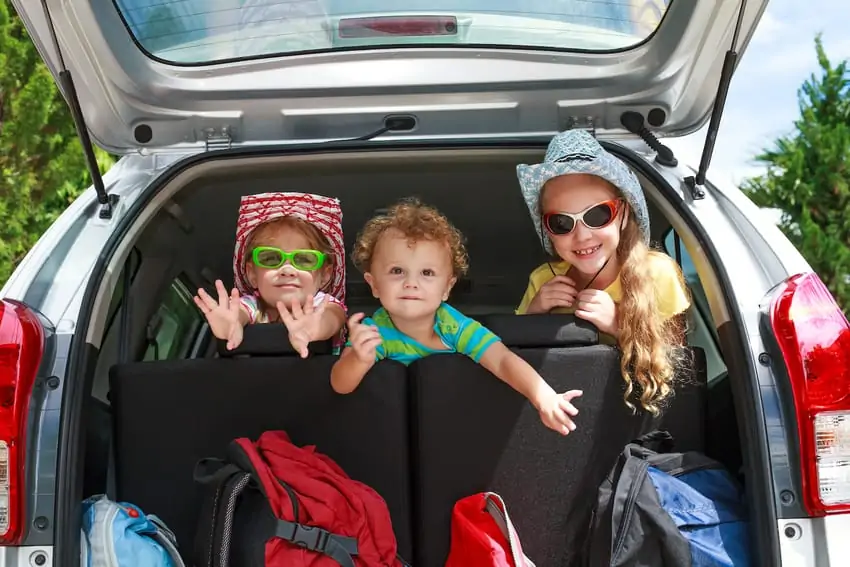I have three kids. Two are pretty self-sufficient at playing and entertaining themselves, often for long stretches of time. The other… well, she’s the polar-opposite.
She’s always been my little sidekick when we run errands or do projects. But then, most time during the day, she’s also my little shadow. If I were to turn around right now, she’d be behind me or at most, within an arm’s reach.
She’s always been like this. When she was little I didn’t mind, I thought it was special that we were so connected.
But now, I can see that its more than being connected. It’s to the point that she sometimes seems incapable of doing anything independently which for me, can be a source of frustration and maybe, if I’m being honest, even a bit of an annoyance.
I know it’s not my duty to occupy my kid’s attention every waking minute but when she struggles to play independently for more than 30-minutes and is 5-years-old…Houston, we have a problem.
It’s no secret that Juliette is a full-blown extrovert. She, like my husband, energize themselves by being around others. She’s gregarious and creative, sweet and a social butterfly. But she also hates to be by herself, which has become a problem.
I game-planned about how to help her build her independent play skills. I researched, tried different methods during our daily solo play time and I’m excited to share what is working for her – and me.
These play building skills are not only useful for preschoolers, but for introducing to babies and toddlers who can benefit from learning to play independently early.
BONUS: 20 Boredom Busting Activities Your Kids Will Love
STOP TRYING TO FILL THE MINUTES WITH “STUFF”
It is not a parent’s duty to occupy the attention of their children, avertedly or inadvertently.
I fell into this trap early and often and am now digging myself out from the bad habit I mistakenly started.
I filled our outings with regular trips, playdates, and special activities from the time the kids were 1 – 3. And then, when the kids were three and I was pregnant, dog-tired and nauseous for 39 weeks straight, a lot of days, couldn’t make it out of the house.
The transition from being on the go and experiencing things outside of the home on regular basis came to a halt. Both kids struggled with the slow-down at first and then once they began to kick afternoon naps after the baby was born, one of them REALLY struggled with not being entertained.
I’m a doting parent and love to be with my kids and experience things together, but I’ve learned that it isn’t my duty to occupy their attention every-waking-minute.
We need to stop taking up all their minutes with entertainment of sorts and give them time to explore and learn to play on their own.
When we leave no spare time for kids to play independently, they begin to “unlearn” how to play – specifically how to play by themselves.
Babies can be placed on a blanket and will look and observe and entertain themselves.
Kids can sit and play in a safe place by themselves.
Whether it starts at 10 minutes and builds itself up to 90 minutes, kids can do these things.
This is a fact.
Often we worry they’ll be bored when they aren’t being entertained but boredom is OK. It has many benefits that are crucial to their development, if we just let them experience it.
THE BENEFITS OF BEING “BORED”
There are countless cognitive and therapeutic benefits to play, but “play” doesn’t refer to just dawdling with toys.
Play in it’s truest form involves using your imagination, creating scenarios with what you have in front of you, it involves creative arts, crafts and costumes… and yes, sometimes toys.
Have you ever noticed that the more you give children – in the form of toys and especially electronic toys that have sounds, lights and require batteries or a charge – the less attention span and creativity they demonstrate?
When we occupy our children’s minds and spaces with toys, it doesn’t allow them the room to experiment, discover, create and imagine.
Independent play helps to also improve attention span, mental focus, creativity, and imagination. Kids who comfortably master playing on their own, will be better equipped to transition from being dependent to independent as well.
This maturity also develops with age but can begin to be taught as early as one-month-old by simply letting a baby explore their environment with fresh eyes.

EXPECTATIONS EQUIVALENT TO AGE & DEVELOPMENT
Toddlers that are in a cognitive learning phase are gaining independence as they begin to play on their own. Sometimes during this period, they test limits and push against the boundaries their parents set to find their limits and assert their power.
We may sarcastically-lovingly refer to as the “terrible twos” or as having “threenanger,” but wanting your attention and even throwing a tantrum about playing by themselves is one of those scenarios where they are testing those limits – yours and theirs.
Start slowly and help your children by creating a safe place for them to play nearby. To transition to independent play, children need guidance but also may require the companionship of having you nearby while they play to feel comfortable.
Your kids won’t feel comfortable being separate from you, unless you project that you are confident with this separation and then they will follow your lead.
When you’re nearby – whether it’s to cook, clean up or have a cup of coffee – for them to look over and see you, can be the comfort they require to play by themselves.
EASE YOUR WAY INTO INDEPENDENT PLAY
You may have a hard time believing that babies and even newborns are old even to participate in independent “playtimes,” but what you’re really providing them with is time to exploring their surroundings through their senses – particularly sight, sound and touch.
When babies turn into toddlers, create a childproofed area where you can place them to play on their own. A playpen is a great option until they’re 16-18months, or a room or area in your home that is safe, quiet and nearby works well.
My five-year-olds play quietly in their rooms with their own toys and books while they’re younger sister naps in her own room. Sometimes they’ll move to the playroom to play on their own in there or take up a seat at the kitchen table to color or do some arts and crafts.
With newborns and babies, they may only want to explore for 5-minutes but that’s a great start. Overtime you slowly build-up the time based on their age and attention span.
My five-year-olds play by themselves for 60 – 90 minutes, but it would be unfair of me to expect my two-year-old to have the same solo play time as them.
DON’T DOMINATE PLAY TIME WITH YOUR KIDS
When you play with your kids outside of the daily time they play independently, be aware of behaviors that can be making solo play more difficult.
It’s easy to take the reigns by directing play with suggestions because you think this is helpful and you’re guiding your children, but dominating this time and telling them what to do is much different than child led play.
Telling children how to play, even showing them the way you to do an art project, is telling them the way you expect them to play. The alternative is to observe your child and gently let them lead the play session. Watch their body language, the way they play and follow their cues.
Kid’s can easily become attached to a parent playing with them when the parent has the habit of controlling the playtime. Children have learned through habit-forming playtimes that a parent is necessary to play and needs to call the shots.
Like in sports, a good teammate is one that includes everyone, takes suggestions, steps back, listens and works together with everyone. A teammate that dominates the possession of the ball, takes all the shots themselves and tells others what to do, is a bad teammate and not so fun to be around.
Become a bystander to your child’s play. Take cues from them, wait for them to ask for your input or for help. Don’t try to narrate playtime. Simply wait, watch and follow their lead.
CREATE LIMITS & BE FIRM
Be firm in setting time for independent play, as well as your own limits. Stick to them.
When it’s time for you to make dinner, be clear this is what you’re doing and the expectations for your child. Offering a choice about what they can do also gives them power and confidence to move ahead with their decision.
For example, “I’m going to make dinner now, I’d like for you to play by yourself while I do this. Would you like to do a craft or build with blocks in the living room?”
BUILD IN THE TIME TO PLAY INDEPENDENTLY
If you want to help your child become good at playing by themselves, the more consistently you incorporate this into your daily routine, the quicker and better they will become at it.
If you already have a pretty good routine, find a place to slide in a 30 – 60-minute chunk of time for your kids to play on their own.
If you don’t have a routine in place, find a time when your children are best suited for this type of play.
For our family, it’s when the baby goes down for a nap and since the older kids no longer nap but need to rest their bodies, this is their designated independent playtime.
The baby may nap for 2 hours but the kids have their own playtime for at least 60 minutes. If they come to me before an hour is up, I give them suggestions for activities and lead them back to their rooms or let them go to the playroom to dive into something new.
The more consistent you are in building independent playtime into your routine, the more your children will embrace it, be confident– and thrive from it.

ENCOURAGE BRAIN-BUILDING ACTIVITIES
Encourage your kids to choose creative play, arts and crafts and brain-building activities to fill their solo playtimes.
Aim to avoid screen time with tablets and TV to babysit your kids. Here are some great 20-Minute Activities and Screen-Free Alternatives to keep your kids busy for a short amount of time to at least cook dinner or read a couple pages of your latest book.
REMEMBER THIS…
The more we do for our children, the less they do for themselves…
The less they think they need to do for themselves…
The less they think they can do for themselves…
The more we do for our kids, the less capable, confident, creative and adaptable they will become.
BONUS: 20 Boredom Busting Activities Your Kids Will Love
Want More?
- 10 Ways to Rock Being a Stay-at-Home Mom
- One Powerful Tip That Will Change Your Parenting Forever
- How to Create a Positive Home (And Why this Will Affect Your Kids Forever)
- 9 Ways to Build Your Child’s Confidence
- The Best Inside Activities for High-Energy Kids
- Stop Feeling Like You Have Mom Burnout
Want even more?
Shop All Parenting Resources
Shop all of our parenting resources from self-regulation tools and managing big emotions to building self esteem and confidence. There are resources for all seasons of life!







